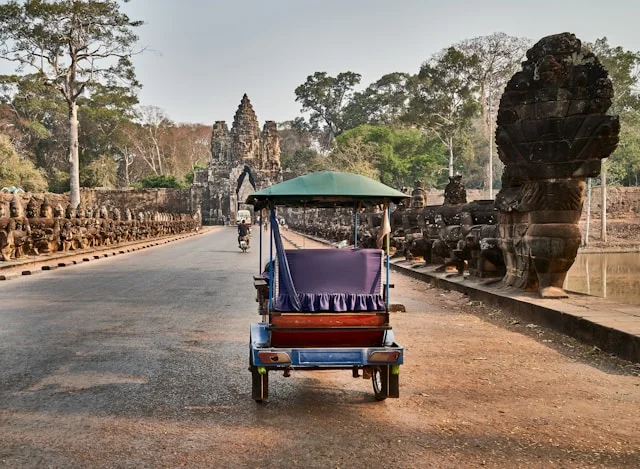Angkor Wat, a UNESCO World Heritage site, is one of the most iconic and breathtaking landmarks in Southeast Asia. Located in Siem Reap, Cambodia, Angkor Wat is a testament to the architectural ingenuity and spiritual devotion of the Khmer Empire. This sprawling temple complex, built in the early 12th century by King Suryavarman II, is dedicated to the Hindu god Vishnu and later transformed into a Buddhist site. With its intricate carvings, majestic towers, and expansive layout, Angkor Wat continues to captivate visitors from around the world.
Historical Significance of Angkor Wat
Angkor Wat was originally constructed as a Hindu temple and served as the state temple and political center of the Khmer Empire. Its design symbolizes Mount Meru, the mythical center of the universe in Hindu cosmology. The temple’s grandeur and scale reflect the power and wealth of the Khmer Empire at its peak. Over the centuries, Angkor Wat transitioned into a Buddhist site, and today it remains a place of worship and pilgrimage for both Hindus and Buddhists.
Architectural Marvels of Angkor Wat
The Central Tower and Main Shrine
The central tower of Angkor Wat rises to a height of 65 meters (213 feet) and is surrounded by four smaller towers, creating a quincunx arrangement. This central sanctuary was once home to the statue of Vishnu and later housed various Buddhist relics. The main shrine, adorned with intricate bas-reliefs and sculptures, showcases scenes from Hindu epics such as the Ramayana and the Mahabharata.
The Outer Enclosure and Moat
Angkor Wat is enclosed by a massive rectangular moat, measuring 1.5 kilometers by 1.3 kilometers, symbolizing the cosmic ocean. The outer enclosure wall, made of laterite, is punctuated by gopuras (entrance pavilions) at each cardinal point. These gopuras are adorned with elaborate carvings and serve as gateways to the temple complex.
The Gallery of Bas-Reliefs
One of the most remarkable features of Angkor Wat is its extensive gallery of bas-reliefs, which stretches for nearly 1,000 meters. These bas-reliefs depict a variety of scenes, including mythological battles, historical events, and celestial beings. The most famous bas-relief is the Churning of the Ocean of Milk, a vivid portrayal of the Hindu creation myth.
Exploring the Angkor Archaeological Park
Ta Prohm: The Jungle Temple
Ta Prohm, also known as the “Tomb Raider Temple”, is renowned for its unique fusion of nature and architecture. The temple is enveloped by massive roots of ancient trees, creating an otherworldly atmosphere. Ta Prohm was built in the late 12th and early 13th centuries and was originally dedicated to the mother of King Jayavarman VII. Visitors can wander through its labyrinthine corridors and marvel at the interplay between man-made structures and the encroaching jungle.
Bayon Temple: The Temple of Smiling Faces
Bayon Temple, located in the heart of Angkor Thom, is famous for its numerous towers adorned with serene and enigmatic smiling faces. Built by King Jayavarman VII, Bayon serves as the state temple and symbolizes the intersection of heaven and earth. The temple’s intricate carvings and bas-reliefs depict scenes of daily life, historical events, and religious rituals, offering a glimpse into the life of the Khmer people.
Banteay Srei: The Citadel of Women
Banteay Srei, often referred to as the “Jewel of Khmer Art”, is a smaller temple complex known for its exquisite and intricate carvings. Constructed from pink sandstone, Banteay Srei is dedicated to the Hindu god Shiva and features some of the finest examples of Khmer artistry. The temple’s delicate and detailed carvings depict various Hindu deities, mythological scenes, and floral motifs.
Tips for Visiting Angkor Wat
Best Time to Visit

The best time to visit Angkor Wat is during the dry season, from November to April, when the weather is cooler and more pleasant. Early mornings and late afternoons are ideal for exploring the temples, as the temperatures are lower and the lighting is perfect for photography.
What to Wear
Visitors to Angkor Wat should dress modestly, with shoulders and knees covered, out of respect for the sacred nature of the site. Comfortable walking shoes are also recommended, as the temple grounds are extensive and uneven in places.
Guided Tours and Audio Guides
To fully appreciate the history and significance of Angkor Wat, consider hiring a knowledgeable guide or using an audio guide. Guided tours provide valuable insights into the temple’s history, architecture, and cultural context, enhancing the overall experience.
Beyond Angkor Wat: Other Must-Visit Sites in Cambodia
Phnom Penh: The Capital City
Phnom Penh, the vibrant capital of Cambodia, offers a rich blend of historical landmarks, bustling markets, and cultural attractions. Key sites to visit include the Royal Palace, the Silver Pagoda, and the National Museum, which houses a vast collection of Khmer art and artifacts.
Siem Reap: Gateway to Angkor
Siem Reap, the closest city to Angkor Wat, is a lively hub for tourists and serves as the perfect base for exploring the Angkor Archaeological Park. The city boasts a range of accommodation options, from luxury hotels to budget guesthouses, as well as a vibrant nightlife and culinary scene.
Kampong Phluk: The Floating Village
For a unique and immersive experience, visit Kampong Phluk, a floating village located on the Tonle Sap Lake. The village consists of stilt houses, schools, and temples, offering a glimpse into the traditional lifestyle of the local fishing communities. Boat tours are available, providing an up-close look at this fascinating way of life.


